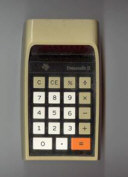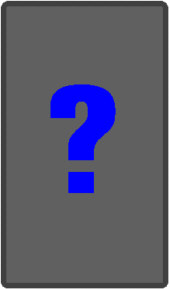
DATAMATH CALCULATOR MUSEUM
 |
DATAMATH CALCULATOR MUSEUM |
Texas Instruments HX-5102 Disk Drive / Controller
| Date of introduction: | Never (Announced: 1983) |
Display technology: | |
| New price: | t.b.d. | Display size: | |
| Size: | t.b.d. | Printer technology: | Ball point Pen |
| Weight: | t.b.d. | Serial No: | |
| Batteries: | Date of manufacture: | ||
| AC-Adapter: | AC9610 | Origin of manufacture: | Japan |
| Precision: | Integrated circuits: | ||
| Memories: | HEX-BUS Device ID: | 101-104 | |
| Program steps: | Courtesy of: | Joerg Woerner |

![]() Texas Instruments designed in 1982 with the HEX-BUS a very innovative interface to connect
intelligent peripherals like printers, modems or even a video interface to its new Compact Computer System
CC-40 and planned to use it with the
never released TI-99/8 home computer.
Texas Instruments designed in 1982 with the HEX-BUS a very innovative interface to connect
intelligent peripherals like printers, modems or even a video interface to its new Compact Computer System
CC-40 and planned to use it with the
never released TI-99/8 home computer.
 The physical interface of the HEX-BUS is a rather simple 8-pin
connector and with peripherals having always two HEX_BUS ports, multiple
peripherals can be connected in a daisy-chain mode. The Hardware of the HEX-BUS uses four Data-Signals [D0, D1, D2, D3], two Handshake-Signals
[HSK], [BAV] and a common ground signal [GND]. The remaining line was reserved
for future use and labeled [FUT]. With the drivers being "open collector", the
interface allows bi-directional data communication, each Byte is transmitted in
two 4-bit words in a Master/Slave protocol. Texas Instruments published not only
the specifications of the HEX-BUS and the software requirements for peripherals,
but even offered two different Intelligent Peripheral Bus Controllers (IBC),
realized as ASICs (Application Specification Integrated Circuits):
The physical interface of the HEX-BUS is a rather simple 8-pin
connector and with peripherals having always two HEX_BUS ports, multiple
peripherals can be connected in a daisy-chain mode. The Hardware of the HEX-BUS uses four Data-Signals [D0, D1, D2, D3], two Handshake-Signals
[HSK], [BAV] and a common ground signal [GND]. The remaining line was reserved
for future use and labeled [FUT]. With the drivers being "open collector", the
interface allows bi-directional data communication, each Byte is transmitted in
two 4-bit words in a Master/Slave protocol. Texas Instruments published not only
the specifications of the HEX-BUS and the software requirements for peripherals,
but even offered two different Intelligent Peripheral Bus Controllers (IBC),
realized as ASICs (Application Specification Integrated Circuits):
|
• TI # 1052911, LSI Logic ASIC L1A0037, 22 pin Package • TP0370, new version, 28 pin package |
Texas Instruments dropped out of the home computer market in March 1984 - after selling more than 2.5 million of the famous TI-99/4A - and production of the CC-40 was ceased immediately after. Consequently was the development of the HEX-BUS terminated and only a few of the already announced HEX-BUS peripherals were manufactured in significant quantities. Interesting fact to know: The TI-74 BASICALC and TI-95 PROCALC computers introduced in 1985 as successor of the CC-40 use a 10-pin Dock-Bus which is compatible to the HEX-BUS and added three signals: [RESET] and System Power Distribution In [PI] and Out [PO] to power peripherals from the computer or the computer from peripherals.
Texas Instruments announced or released during the short live of the Compact Computer 40 eight different products like printers, plotters and even a serial interface using the HEX-BUS Interface. Additional peripheral devices were planned or released from Third Party vendors but are not listed as of now in our overview:
Part |
Name / Description |
MSRP (1983) |
Status |
| HX-1000 | Printer / Plotter 4 colors | $199.95 | Series |
| HX-1010 | Printer 80 (Thermal ribbon) | $249.95 | Series |
| HX-1100 | Video Interface | $99.95 | Prototype |
| HX-2000 | Wafertape Digital Tape Drive | $139.95 | Prototype |
| HX-3000 | RS-232 Interface | $99.95 | Series |
| HX-3000/P | RS-232 + Parallel Interface | $124.95 | Series |
| HX-3100 | Data Modem | $99.95 | Series |
| HX-5102 | Disk Drive/Controller | t.b.d. | Prototype |
Texas Instruments announced with the HX-5102 Disk Driver Controller an external DS/DD (Double-Sided, Double-Density) 5¼" floppy drive with a controller for up to four drives. It connects with the HEX-BUS Interface to the Compact Computer System CC-40 and other devices supporting the HEX-BUS specifications.
The HX-5102 Disk Driver / Controller was unfortunately never released and only a few prototypes are out in the wild.
![]()
If you have additions to the above article please email: joerg@datamath.org.
© Joerg Woerner, October 25, 2019. No reprints without written permission.